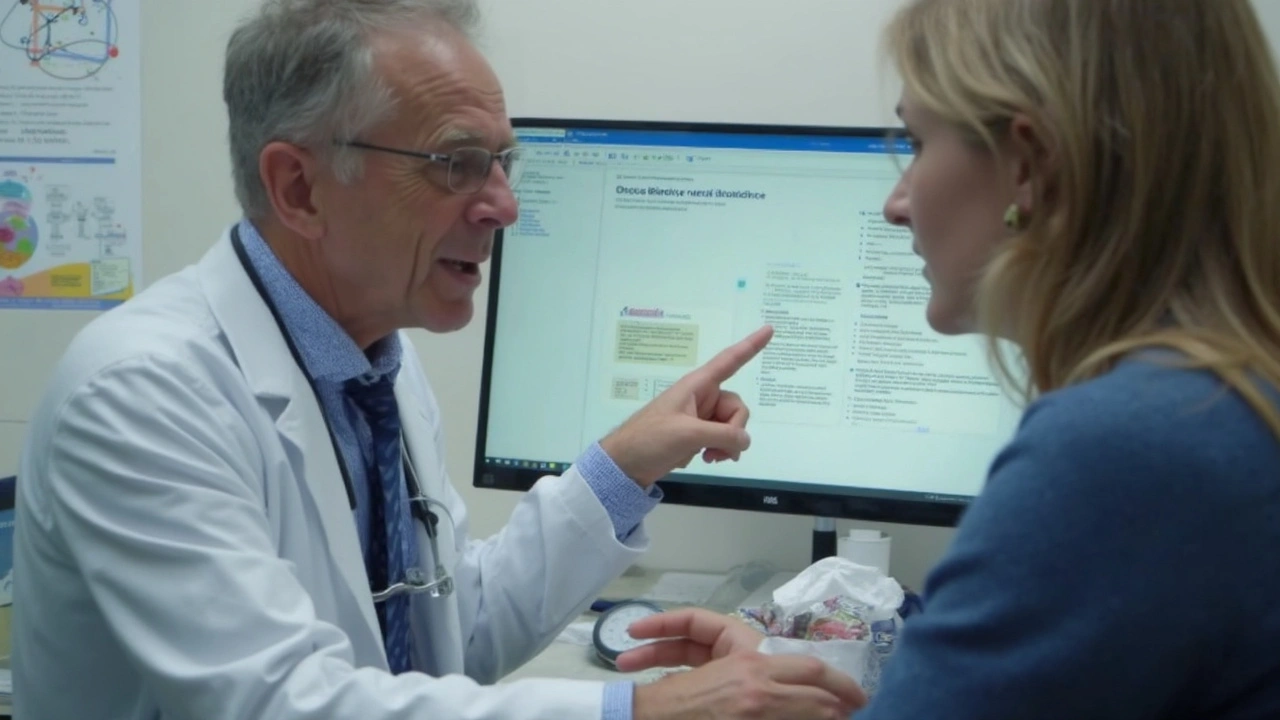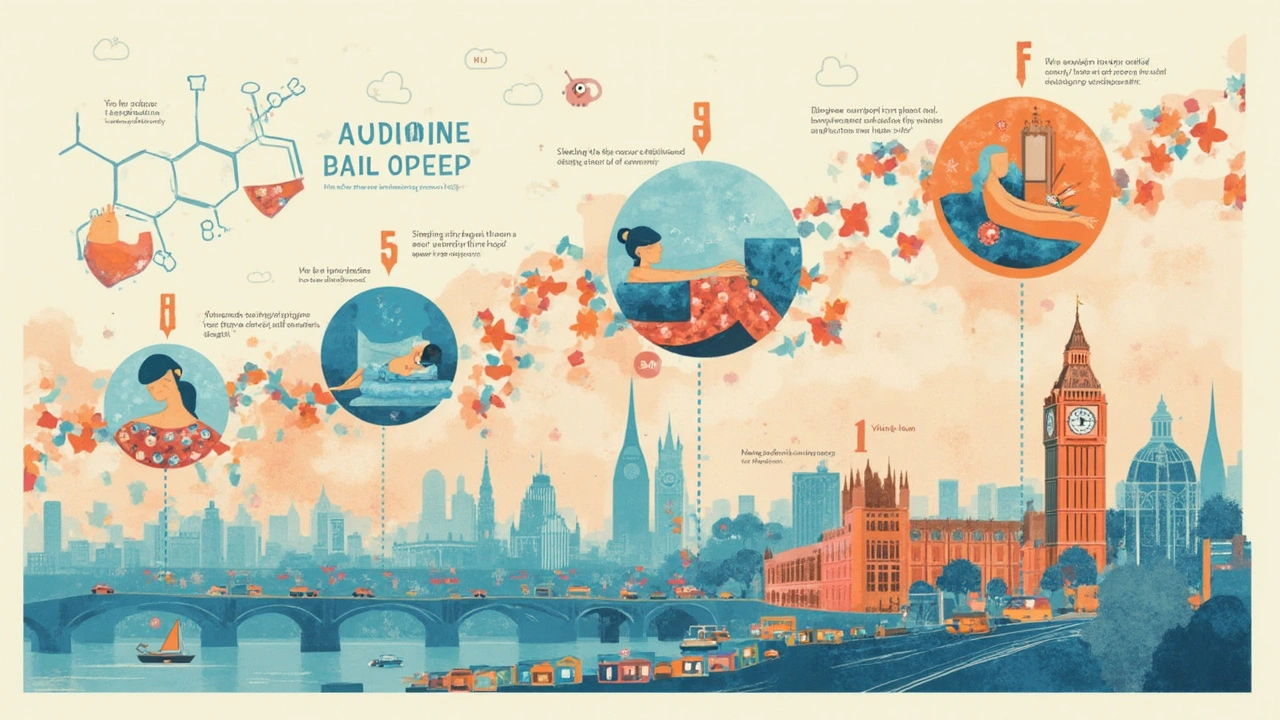If you look inside many first-aid cabinets, you'll probably spot tablets of paracetamol or ibuprofen, but rarely clonidine. Yet, this unassuming medication pops up in places you wouldn’t expect—from school nurse drawers in Adelaide to psychiatry clinics in Brisbane. The story of clonidine gets stranger the deeper you go: once just for high blood pressure, now it’s being used to quiet ADHD outbursts, calm withdrawal shakes and even help kids with sleep problems. Its versatility would make a Swiss Army knife jealous. People swear by it for very different reasons. But is clonidine a miracle, a compromise, or just a misunderstood workhorse?
What is Clonidine? The Facts and Its Many Surprises
People often call clonidine a "jack-of-all-trades" drug, but that title doesn’t give enough credit. This medication started its life in the 1960s, developed to control high blood pressure. The way it works is surprisingly clever—it tricks certain nerves in your brain into thinking your blood pressure is already lower than it actually is, which signals your body to stop releasing stress hormones that tighten up blood vessels. The end result? Your blood pressure drops, your heart slows down, and you avoid some scary long-term risks like strokes or heart attacks. In Australia, it's mostly available as tablets under brand names like Catapres or as a patch for steady, all-day release.
Here’s where clonidine gets interesting: after doctors noticed it made patients sleepy and less anxious, they started using it far outside the world of heart health. In paediatrics, some doctors prescribe clonidine to settle hyperactive behaviour and reduce "tics" in kids with Tourette’s syndrome. Parents of kids with ADHD sometimes find that clonidine helps with the severe restlessness or sleep problems that stimulants like Ritalin can trigger. Then you’ve got addiction specialists giving clonidine to ease opioid withdrawal. Emergency rooms sometimes use it to handle severe agitation, and in older adults, it can even help tamp down "hot flashes" during menopause.
A lot of people don’t realise that clonidine isn’t a controlled substance, but it still requires a prescription. It’s not something you pick up over the counter—it’s too strong for that. And while blood pressure meds might sound boring to most people, clonidine’s brain-targeting action has led to it showing up all over modern medicine. The dosage is a moving target, and your doctor will tweak it for whatever condition you’re facing. For example, someone taking it for high blood pressure may start with a low dose, maybe 50 micrograms twice a day, while a child with sleep issues might just get a tiny dose at bedtime.
Here’s a taste of just how adaptable clonidine can be, with a peek at the wide range of conditions it treats globally:
| Condition | Usual Clonidine Use |
|---|---|
| High Blood Pressure | Daily tablet or patch |
| ADHD | Low-dose tablet at bedtime or split doses |
| Opioid Withdrawal | Short-term, frequent dosing |
| Tourette's Syndrome | Regular tablet dosing |
| Hot Flashes | Tablet, sometimes patch |
| Sleep Disorders (in children) | Low-dose tablet |
What’s so special about clonidine compared to other medications? For one thing, when people can’t tolerate stimulants or sedating antihistamines, clonidine is sometimes the safest fallback, especially for kids. Plus, the patch option lets people avoid "spiky" doses up and down—it’s a steady trickle into the bloodstream, which many find easier on the system. Yet, that doesn’t mean it’s free of drawbacks or surprises. If you’ve ever missed a clonidine dose, you’ll know how quickly the body can swing the other way.

How Clonidine is Prescribed and Used: Dosing, Practical Tips, and Warnings
Doctors in Australia are usually trained to start low and go slow with clonidine. That’s not just a saying—it’s how you dodge two big problems: sudden drops in blood pressure and the "rebound" effect if you forget a dose. For high blood pressure, the starting dose usually sits at 50–100 micrograms twice a day, adjusted up as needed. The tablets come in small strengths, like 100 micrograms, so you can split tabs easily. When used for children’s sleep or ADHD, the doses are much tinier. The dosing chart for clonidine tends to look like it was written for a math exam, with all the decimals and micrograms, but that’s only because doctors have to tailor it so carefully.
Here’s a rundown of practical steps and tips if you’re starting clonidine or caring for someone who’s prescribed it:
- Try to take it at the same times every day—building a rhythm helps you remember.
- Clonidine can be sedating, so bedtime doses are common, especially for kids with sleep troubles.
- If you’re on the patch, change it once a week and rotate the spot (shoulder one week, hip the next) to keep your skin healthy.
- If you miss a dose by a few hours, take it when you remember. But if you’re close to your next dose, skip the missed one—don’t double up.
- Never suddenly stop clonidine unless your doctor tells you. Stopping it fast can skyrocket your blood pressure—some emergency rooms in Australia see people every year with “rebound hypertension” from missing their clonidine.
- Keep an eye out for dizziness when you stand up. Clonidine can drop your blood pressure quickly, especially in older adults or those already on other blood pressure meds.
- If your kid is on clonidine, teachers and caregivers should be in the loop, because a sleepy or suddenly dizzy child is no joke.
- Alcohol can make the sedating effects worse, so skip the nightly wine (or beer).
- Tell your pharmacist what other meds you’re on—clonidine can interact in sneaky ways with antidepressants, beta-blockers, and some cold medications.
For people in high-stress jobs, like bus drivers or construction workers, it’s worth talking to a doctor about how clonidine might affect alertness or reflexes. If driving or using machinery is part of life, don’t assume you’ll be able to "push through" any drowsiness. Some workplaces in Adelaide now ask employees to let supervisors know if they're starting meds with sedative effects. Schools are another place where medications like clonidine can come up: lots of teachers now keep an eye out for dose changes or new side effects.
Interestingly, a 2022 survey of GPs in metropolitan Sydney showed that over 60% had prescribed clonidine for reasons other than blood pressure—like ADHD symptoms, sleep issues, or withdrawal. That number wasn’t nearly as high ten years ago, pointing to how much trust has grown in the drug outside its original purpose.
But while dosing flexibility is a strength, it can also create risks. Home accidents with double-dosing or accidental ingestion by other family members sometimes make the local news, particularly when tablets are left out by mistake. Always keep these medications out of reach—and make sure the person taking them knows what each pill looks like.
One cool thing about clonidine? Unlike many sleep medications, it’s not habit-forming. So you don’t usually need to "taper" it as carefully as benzodiazepines. Still, the rebound hypertension is no small thing. That’s why pharmacies sometimes put giant stickers on clonidine packs warning people not to stop suddenly.
For stubbornly high blood pressure that doesn’t respond to first-line treatments, clonidine is often considered a “rescue” medication. It’s not first choice anymore, but for those who’ve failed with ACE inhibitors, beta-blockers, and calcium channel blockers, it’s still very much on the menu. It’s especially handy for people with kidney problems, because it relies less on kidney clearance than some alternatives.

Clonidine Side Effects, Risks, and What Patients Should Actually Expect
Nothing in medicine is a free lunch, and clonidine is no exception. The most common side effect, hands down, is drowsiness. About a third of people report this, especially during the first couple of weeks. Fatigue, dry mouth (as if you’ve been chewing cotton), and occasional headaches are right up there too. Some people also find themselves feeling lightheaded when they stand up too quickly—this can be alarming, especially for older adults who already risk falls. Kids, on the other hand, might just get irritable or have more emotional swings, especially if the dose is too high.
There’s also a cluster of gastrointestinal side effects—think constipation, stomach pain, or nausea. Not everyone gets these, but if you already struggle with sluggish bowels, you might want to have some fibre-rich snacks handy. A less obvious but important risk: while clonidine calms the heart, in rare cases it can slow it down too much. That’s why doctors usually check for a slow heart rate before bumping up your dose. Every script also comes with the warning that stopping clonidine abruptly can cause rebound hypertension (dangerously high blood pressure that bounces back higher than before). This rebound effect is no medical myth—Australian emergency departments see a steady trickle of cases every year.
Younger patients, especially those using clonidine for ADHD or sleep, can have dry, itchy skin when using patches, and there’s a rare risk of allergic reaction. Some caregivers in Adelaide swap patch spots and use a dab of moisturiser to fight the irritation. Watch for redness in the patch area, swelling, or fever—then call the doctor just in case.
Let’s talk about interactions. Clonidine can have sneaky relationships with other drugs. Mixing it with antidepressants, antipsychotics, or even over-the-counter cold meds can bring on wild swings in heart rate or sedation. Always run your medication list by a pharmacist. Also, if you’re on beta-blockers and need to stop both drugs, your doctor will tell you to stop the beta-blocker first—there’s a good reason, since stopping clonidine first can cause a dangerous blood pressure spike.
If you’re pregnant or breastfeeding, clonidine isn’t usually the first choice. While research suggests it isn’t a big threat to developing babies, there just isn’t enough data for most doctors to feel safe recommending it except in special cases. The ARIA guidelines in Australia (as of 2023) list clonidine as a backup but not a first-line treatment for pregnancy-induced hypertension.
Finally, a few "hacks" and extra tips from GPs and patients in Adelaide: If dry mouth is an issue, sipping water constantly helps, but sugar-free gum really shines here. For sleep, clonidine works best when paired with low lights and quiet environments—the drug opens the door to sleep, but you still need to walk through it. And if you ever feel your heart racing or pounding after missing a dose, don’t tough it out alone; call your doctor or check in to urgent care.
Clonidine is proof that a drug can shed its old reputation as just a blood pressure pill and become something much richer. Whether for taming restlessness, smoothing out withdrawal, or saving stubborn cases of high blood pressure, it proves old medicines can teach medicine new tricks. Still, it needs respect, careful timing, and honest conversations with your doctor—because as with most things in life, what looks harmless can pack a real punch.


So, here’s the deal with Clonidine that nobody really talks about openly. Yeah, it's marketed heavily as a blood pressure med, but the government and big pharma are pushing it hard because it’s got these covert uses that they kinda skim over in the mainstream narratives.
Think about it: it calms the central nervous system drastically, which means it’s also being rolled out for things like ADHD and even opioid withdrawal symptoms quietly, but what are they not telling us? How it interferes with natural brain chemistry on a deeper level, potentially messing with your vigilance in ways we cannot yet fully quantify.
There’s always a darker layer with medications like this, you gotta question the motives behind why an old drug suddenly becomes a hot topic again. Follow the money trail and the research grants, and you'll see the selective spotlight on certain uses, while the side effects and addictive potentials are conveniently downplayed or buried.
Anyway, just some food for thought before anyone jumps in blindly. Stay vigilant, folks, and question everything when it comes to pharmaceuticals.
Honestly, it’s about TIME someone talked about the many sides of Clonidine!!! People always focus so narrowly on blood pressure, but this medicine has so much more to offer, AND people should KNOW all the facts!!!
For example, the article points out its uses in ADHD and withdrawal management, which is crucial because people suffering from these conditions are so often ignored in favor of the 'big diseases'.
Also, let’s not forget the importance of discussing side effects thoroughly, because medication is not just a magic cure—it impacts whole lives!!!
Everyone deserves to be fully informed before putting anything into their bodies, so thank you for such a detailed guide!!!
Look—Clonidine is just another piece of our healthcare system trying to keep America strong and productive!!! It’s not complicated.
People whining about secret agendas are missing the big picture here—this drug helps thousands control their high blood pressure and even some other conditions effectively!!!
We need to back the science, support our medical professionals, and not fall for conspiracy theories that just slow progress and confuse the good hard-working people who rely on these medications daily!!!
Let’s keep the focus on facts, not fear-mongering!!!
It's really refreshing to see a thorough guide like this. Clonidine’s range of uses beyond just blood pressure is often overlooked, but it truly gives hope to a lot of patients who don't have many options.
Medication is such a personal journey, and knowing what to expect, what risks exist, and how to manage them empowers us all. It's about quality of life, not just numbers on a chart.
This article does a great job reminding us that medicine is evolving, and old drugs like Clonidine can find new purpose that brings relief and stability to many people’s lives.
Thanks for sharing this—knowledge is power!
Hey, just chiming in to say I’ve seen Clonidine work wonders for people dealing with withdrawal symptoms, especially opioid withdrawal. It's not a cure-all, but it definitely helps smooth out the process.
And like the post says, the side effects can be tricky, so anyone thinking about starting it should talk to their doc thoroughly.
It’s not a one-size-fits-all, but having more tools in the kit is never a bad thing. Plus, dosage is key, and following instructions to the letter makes a huge difference in outcomes.
Always be honest with your health provider about how you’re feeling once you start!
You all really think we need ANOTHER standard pill to treat whatever ails us???
This ‘guide’ just feeds the endless pharmaceutical cycle that keeps us dependent on drugs like Clonidine without encouraging any real self-reflection or lifestyle changes.
Sure, it has “many uses,” but the deeper question is whether we’re just patching symptoms rather than solving root causes, which almost never get addressed.
Medicine shouldn’t just be about 'taking a pill every day'—that’s lazy thinking, but it’s marketed that way.
Wake up people, the system wants you hooked and compliant.
There’s absolutely something gnarly going on with Clonidine history. I bet if you look deeper, there’s government ties that go beyond health care.
A drug this cheap and old suddenly becomes popular again? Nah, there’s strings being pulled behind closed doors.
This stuff influences brain chemistry big time, and that’s never simple or innocent.
Don’t just trust what they spoon-feed us about benefits, 'cause there’s always a shadow side.
Uhmm, can someone pls xplain why the dosage instructions r so varied? One doc says 0.1mg, next doc says 0.3mg, then the pharmacy info says something else?
This kinda inconsistency freaks me out a bit.
Also, what are the major side effects? The article mentions a lot but what do folks who actually took it experience day to day?
Anyone willing to share some personal stories or tips to handle this med?
Great question about dosage variability! From what I understand, Clonidine dosing really depends on the condition being treated and individual sensitivity.
Doctors usually start low and titrate up carefully because the risk of side effects like dizziness or dry mouth increases with dose.
Also, it’s important to never stop it abruptly, because that can lead to rebound hypertension, which can be dangerous.
Listening carefully to your doctor, and reporting side effects promptly is crucial. Everyone's response varies.
Omg y’all 😱 Clonidine was a game changer for me dealing with withdrawal symptoms and anxiety!!!
Yeah, the side effects can get a bit annoying sometimes but nothing compared to what I went through before.
It seriously felt like a lifeline—like a little ray of hope 🌟
If you’re struggling with usage or just starting it, pls be patient with yourself and your body 💖
This guide is amazing because it doesn’t sugarcoat the risks but also shows the bright side 🙂
This entire discussion brings to light the balance we must all consider between scientific progress and the philosophical questions of reliance on pharmaceuticals.
Clonidine, like many medications, serves as a reminder that medicine isn’t merely about curing a disease, but managing conditions within the complex fabric of human experience.
We must weigh the benefits against the costs, not only physical but societal and ethical.
Ultimately, informed consent and thoughtful use remain paramount.